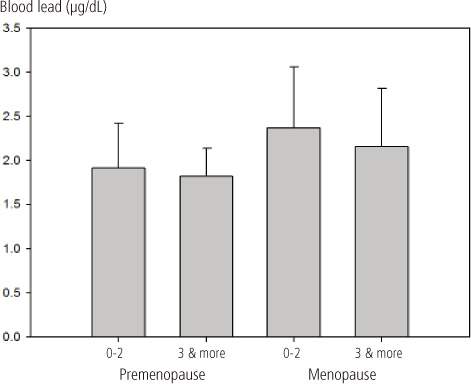Korean J Obstet Gynecol.
2012 Apr;55(4):250-256. 10.5468/KJOG.2012.55.4.250.
The change of blood lead levels in menopausal women and its association with relevant factors
- Affiliations
-
- 1Department of Obstetrics and Gynecology, Soonchunhyang Cheonan Hospital, Soonchunhyang University College of Medicine, Cheonan, Korea. jgsunwoo@schmc.ac.kr
- 2Institute of Environmental and Occupational Medicine, Soonchunhyang University, Asan, Korea.
- KMID: 1992621
- DOI: http://doi.org/10.5468/KJOG.2012.55.4.250
Abstract
OBJECTIVE
This study assessed blood lead in women in relation to menopause and its association with other related relevant factors to evaluate the impact of menopausal status on blood lead levels in women.
METHODS
Eighty three menopausal women and 52 premenopausal women without known occupational lead exposure were included. Blood lead was measured by atomic absorption spectrophotometry. Follicle-stimulating hormone (FSH) and Lutenizing hormone (LH) were measured in addition to hemoglobin, hematocrit and body mass index as an study variables. Information on smoking and drinking status were also obtained.
RESULTS
The mean (95% confidence intervals) level of blood lead in menopausal women was 2.27 microg/dL (2.12-2.41 microg/dL) which was significantly higher than premenopausal women (1.89 microg/dL, 1.76-2.02 microg/dL), but there was no statistical difference of mean blood levels between perimenopausal and postmenopausal women. In a multivariate regression analysis after adjusting for age, body mass index hemoglobin, drinking and smoking status, only menopausal status was a significant predictor of increases in log transformed blood lead without any significant contribution of FSH and LH.
CONCLUSION
These results confirmed that menopausal status was associated with significant increase of blood lead levels in Korean women who were not occupationally exposed to lead.
Keyword
MeSH Terms
Figure
Reference
-
1. Toxicological profile for lead [Internet]. Agency for Toxic Substances and Disease Registry (ASDR). 2007. cited 2012 Mar 20. Atlanta (GA): ASDR;Available from: http://www.atsdr.cdc.gov/toxprofiles/tp.asp?id=96&tid=22.2. Kim NS, Lee BK. National estimates of blood lead, cadmium, and mercury levels in the Korean general adult population. Int Arch Occup Environ Health. 2011. 84:53–63.3. Symanski E, Hertz-Picciotto I. Blood lead levels in relation to menopause, smoking, and pregnancy history. Am J Epidemiol. 1995. 141:1047–1058.4. Hernandez-Avila M, Gonzalez-Cossio T, Palazuelos E, Romieu I, Aro A, Fishbein E, et al. Dietary and environmental determinants of blood and bone lead levels in lactating postpartum women living in Mexico City. Environ Health Perspect. 1996. 104:1076–1082.5. Jackson LW, Cromer BA, Panneerselvamm A. Association between bone turnover, micronutrient intake, and blood lead levels in pre- and postmenopausal women, NHANES 1999-2002. Environ Health Perspect. 2010. 118:1590–1596.6. Hu H. Bone lead as a new biologic marker of lead dose: recent findings and implications for public health. Environ Health Perspect. 1998. 106:Suppl 4. 961–967.7. Hu H, Rabinowitz M, Smith D. Bone lead as a biological marker in epidemiologic studies of chronic toxicity: conceptual paradigms. Environ Health Perspect. 1998. 106:1–8.8. Silbergeld EK, Schwartz J, Mahaffey K. Lead and osteoporosis: mobilization of lead from bone in postmenopausal women. Environ Res. 1988. 47:79–94.9. Korrick SA, Schwartz J, Tsaih SW, Hunter DJ, Aro A, Rosner B, et al. Correlates of bone and blood lead levels among middle-aged and elderly women. Am J Epidemiol. 2002. 156:335–343.10. Krieg EF Jr. The relationships between blood lead levels and serum follicle stimulating hormone and luteinizing hormone in the third National Health and Nutrition Examination Survey. Environ Res. 2007. 104:374–382.11. Garrido Latorre F, Hernández-Avila M, Tamayo Orozco J, Albores Medina CA, Aro A, Palazuelos E, et al. Relationship of blood and bone lead to menopause and bone mineral density among middle-age women in Mexico City. Environ Health Perspect. 2003. 111:631–636.12. Nash D, Magder LS, Sherwin R, Rubin RJ, Silbergeld EK. Bone density-related predictors of blood lead level among peri- and postmenopausal women in the United States: The Third National Health and Nutrition Examination Survey, 1988-1994. Am J Epidemiol. 2004. 160:901–911.13. Hurd WW. Berek JS, Novak E, editors. Menopause. Berek & Novak's gnecology. 2007. 13th ed. Philadelphia (PA): Lippincott Willians & Wilkins;981–991.14. National Institute for Occupational Safety and Health (NIOSH). Cassinelli ME, O'Connor PF, editors. Lead by GGAAS: method 7105. NIOSH manual of analytical methods. 1994. 4th ed. Washington, DC: DHHS (NIOSH) Publication.15. Potula V, Kleinbaum D, Kaye W. Lead exposure and spine bone mineral density. J Occup Environ Med. 2006. 48:556–564.16. Popovic M, McNeill FE, Chettle DR, Webber CE, Lee CV, Kaye WE. Impact of occupational exposure on lead levels in women. Environ Health Perspect. 2005. 113:478–484.17. Potula V, Kaye W. The impact of menopause and lifestyle factors on blood and bone lead levels among female former smelter workers: the Bunker Hill Study. Am J Ind Med. 2006. 49:143–152.18. Kosnett MJ, Wedeen RP, Rothenberg SJ, Hipkins KL, Materna BL, Schwartz BS, et al. Recommendations for medical management of adult lead exposure. Environ Health Perspect. 2007. 115:463–471.19. Muldoon SB, Cauley JA, Kuller LH, Scott J, Rohay J. Lifestyle and sociodemographic factors as determinants of blood lead levels in elderly women. Am J Epidemiol. 1994. 139:599–608.20. Makino S, Shimizu Y, Takata T. A study on the relationship between blood lead levels and anemia indicators in workers exposed to low levels of lead. Ind Health. 1997. 35:537–541.21. deSilva PE. Blood lead levels and the haematocrit correction. Ann Occup Hyg. 1984. 28:417–428.22. Ahamed M, Siddiqui MK. Environmental lead toxicity and nutritional factors. Clin Nutr. 2007. 26:400–408.23. Bellinger DC. Very low lead exposures and children's neurodevelopment. Curr Opin Pediatr. 2008. 20:172–177.
- Full Text Links
- Actions
-
Cited
- CITED
-
- Close
- Share
- Similar articles
-
- Menopausal Knowledge and Management in Peri-menopausal Women
- A Comparative Study of Depression and Stress Related Life Events among Women in the Menopausal Stage
- Effects of Koryo Hand Therapy on Menopausal Symptoms and Blood Lipid Levels in Middle-aged Women
- The Menopausal Age and Climacteric Symptoms, and the Related Factors of Korean Women
- A Comparative Study on Climacteric Symptoms of Natural Menopausal Women and Artificial Menopausal Women


